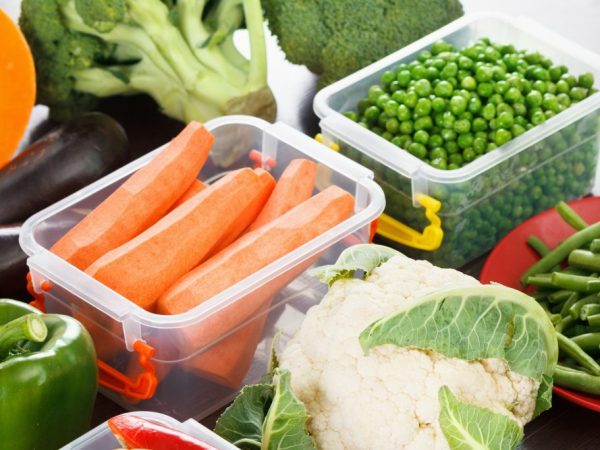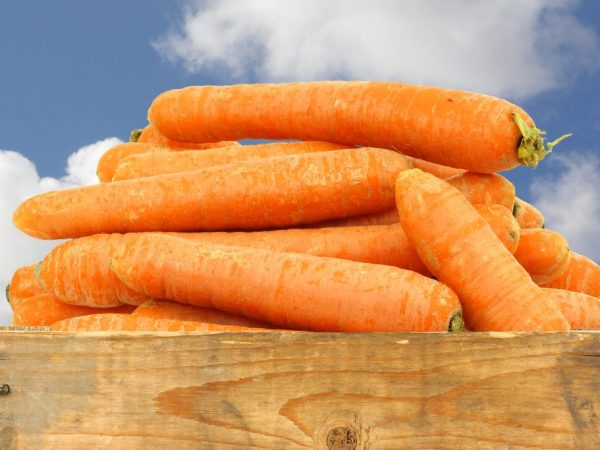Rules for storing carrots in winter
Carrots are one of the most commonly used root vegetables in cooking. After harvesting, the question of its storage arises. There are many ways to store carrots in an apartment and in special rooms: cellars and storage facilities.

Rules for storing carrots in winter
Preparation stages
The preparation of carrots for storage directly affects the duration and quality of preservation of the root crop. Vegetable preparation rules:
- choose healthy roots that are not affected by mold or rot;
- cut off all tops, leaving 1-2 mm;
- wash the vegetable from dirt and earth;
- dry the remaining moisture;
- sort fruits by size.
Such vegetables are suitable for long-term storage. If any formations have grown on them or they have sprouted, they are not advised to store them for a long time. To reduce the efforts for the preparation of the root crop, the harvest is carried out on a dry day.
Storage in the apartment
Storing carrots is more difficult than storing beets because elongated fruits spoil faster than round ones. If there are no dedicated rooms for this procedure, try storing the vegetable in an apartment. For this you need a room:
- Restricted from household processes to store carrots at -1 ° C to 2 ° C.
- Other vegetables and fruits are not placed in the same room.
- Air humidity 90% -95%.
- Lack of ventilation system. Air should almost not flow to the vegetable.
It is difficult to create such conditions in an apartment. This method is possible on a glazed balcony or loggia.
You can store the root crop at home in the refrigerator, but it will not work to prepare large volumes of vegetables for the winter:
- prepare polyethylene bags (packages);
- packaged 2-3 root vegetables in one package;
- before placing in the refrigerator, the fruits are cooled during the day.

Carrots are prepared for storage at home
If you do not first cool and remove moisture, condensation will form and the fruit will rot.
Peeled, grated or chopped carrots are stored in the freezer in cubes or balls. Before that, trim the skin and wash. When frozen, the vegetable does not lose its beneficial properties, it will also speed up the preparation of dishes. Defrost the grated root vegetable at room temperature.
Keeping carrots in an apartment is no easy task. So that it does not sag and rot, it is necessary to create optimal climatic conditions for the fruits.
Cellar storage
You can store carrots in the cellars in winter. Prepare for storage in the same way as for home conditions.
The cellar must be isolated from groundwater, insulated and well ventilated. The optimum temperature should not fall below 5 ° C. Before placing a new batch of vegetables, it is necessary to harvest the remnants of the entire previous crop.
In boxes
Storing carrots in a box for the winter is an affordable way for many people. Before this, the tree is well disinfected, inspected for damage and rot. The method is as follows:
- The fruits are tightly packed in boxes made of wood or thick cardboard.
- They are placed 10-15 cm from the wall.
- Podtars are used so that the boxes do not get damp from the floor or walls.
- No more than 20 kg of fruit is placed in one box.
This technology is compact and allows you to harvest a lot of vegetables. It is allowed to use sawdust for pouring fruits.

Convenient storage in drawers
In polyethylene
This is not the most efficient way to keep the fruit intact until spring. However, it has the advantage of being cheap to store and not time-consuming to pack.
The fruits are stored in plastic bags or cling film (it must be folded in several layers). They are laid out on shelves or wooden stands. Holes are made in the film through which moisture flows and air enters. If this is done badly, then the risk of fruit rotting increases. Incorrect storage temperature will also have a negative effect.
In bags with onion skins
The fruits are also stored in bags. They are sprinkled with onion peels. It absorbs excess moisture and prevents microorganisms from multiplying, which lead to decay. Air is removed from the bags and stored in basements or cellars.
With coniferous sawdust
Until spring, the harvest will stand, strewn with sawdust of coniferous trees - they absorb moisture, phenolic substances in the composition kill harmful bacteria.
Sawdust is poured onto the shelves in the cellar. Do not store fruits on sawdust scattered on the floor of the cellar. They will quickly rot.
Sand pyramids
This technology is suitable for a large cellar. Storing carrots in the sand is done as follows:
- A lot of sand is poured onto the floor. It should be clean, slightly damp.
- Fruits are spread on it at a distance from each other.
- Sprinkle a ball of sand again.
- The next row is laid out in a checkerboard pattern.
The fruits should not be in contact with each other. Long standing sand is moistened from time to time, and it is advisable to disinfect and ignite it before using it in the cellar.
Wet sand and chalk
This method requires chalk powder. It is mixed in sand and placed in a wooden box. The fruits are stuck vertically, with the thick end up and sprinkled on top. Black spots of rot do not appear, because chalk has antifungal properties (creates an alkaline environment). Also, carrots do not wither, but remain juicy and tasty.
Chalk solution
The chalk solution prevents diseases and fruit rot. There are two ways to chalk a vegetable for the cellar:
- Make a chalky solution with water. Each fruit is treated in solution, dried and removed to the cellar. Rinse vegetables before use.
- Sprinkle the vegetable with chalk powder: 200 g of chalk per 10 kg of carrots.
These methods of storing carrots for the winter are relatively easy to use and do not require a significant investment of effort and money.
Clay wrap
For the basement, treating carrots with clay before storing them is one of the most effective ways to keep a vegetable longer. This requires purchasing or excavating clay. Follow these steps:
- Dissolve water and clay in a bucket until smooth. The mass should be fluid and sticky.
- Dip each fruit in the clay.
- Leave to dry until the clay hardens.
Once dry, place the vegetables in the cellar. For convenience, arrange them in boxes or baskets, so the vegetable will last longer.
Approximate shelf life
Storage periods:
- up to 2 months in plastic bags (in the refrigerator);
- up to a year in a clay shell in a cellar;
- up to 8 months in the sand in the cellar;
- up to a year in coniferous sawdust;
- up to 8 months in closed boxes.
Choosing the right varieties will also help preserve salad carrots for the winter. Among them are Moscow Winter, Nantes and Chantane. These varieties are sometimes left to winter in the ground.
Conclusion
There are different ways of storing carrots in winter. Depending on how long fresh carrots will need to be stored and the availability of space, it is easy to choose the best one. It is important to observe the storage temperature of the carrots, humidity and ventilation. It is most effective to preserve the vegetable in clay and coniferous sawdust.


